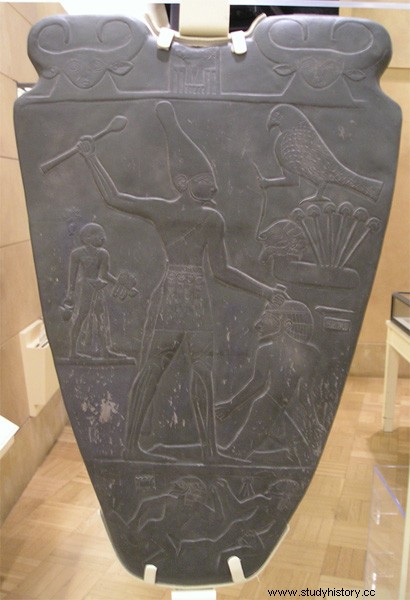1st and 2nd DYNASTIES:
The Thinite period marks the official beginning of the history of Egypt . According to the writings of the Egyptian priest Manetho (dating from the III th century BC), Narmer (Menes in Greek) is the first Pharaoh official of the line of ancient Egypt. Manetho counts more than 500 sovereigns whom he classifies in 31 dynasties. Modern historians count only 30 dynasties which they group together by major periods, the first of which is the Thinite period . The first two dynasties of pharaohs, more mythical than historical, founded Egypt.
AROUND 3,300 B.C. AD

Invention of hieroglyphic writing:
The Egyptians begin to use pictograms to write on papyrus, a paper made with a kind of reed. Lively and colorful, the hieroglyphs are sacred images for the Egyptians and they form a complex script, with a rich vocabulary and complicated grammar. They are present everywhere:on the walls of temples, on the walls of sarcophagi, on the bases of statues, etc. Some hieroglyphs are ideograms , they represent an object, a being or an action. Other hieroglyphs, the phonograms, about 150, evoke sounds. The drawings are used for their phonetic value, as in a rebus.
CIRCA 3100 BC

Unification of Upper and Lower Egypt:
The kingdoms of Upper Egypt and Lower Egypt clash in a battle won by King Narmer (who may also be King Menes, a doubt remains) from Thinis in Upper Egypt. Thinis becomes the capital of his new kingdom and he also builds a second capital in Memphis, where the 2 Egypts meet. (Picture: Verso of the Narmer tablet:It represents the king wearing the white crown of Upper Egypt who triumphs over his enemies. The back of the tablet depicts Narmer wearing the red crown of Lower Egypt and counting the corpses of his enemies whose heads and penises have been severed. Everything suggests that the lands of Lower Egypt have not been conquered in peaceful negotiation…)
The pharaohs:
Egyptian kings are called pharaohs . This word is a transcription of a Hebrew word and it was transmitted to us by the Greeks. It will only be used by the Egyptians from the New Empire. Before that, the scribes rather used the terms “the king” (nesout), “the lord” (neb) or “his majesty”. The pharaohs have a divine and human nature and they are real living gods who were created by the gods themselves to rule Egypt. Son of Atum-Re, god of the Sun, in the carnal sense of the term and reincarnation of Horus, the falcon-god, their blood and lineages are sacred. They become from the Old Kingdom, Atum-Ra itself.

Birth of absolute power:
The pharaohs begin to establish a strong and sacred institution of kingship. They have control over land, fields, irrigation canals, labor, mines, tribes paid by foreign colonies, etc. Pharaoh owns everything, all of Egypt belongs to him. Its role is to ensure the survival and growth of civilization. In the New Kingdom, the Pharaoh also holds a trade monopoly.
Cult of the Dead:
The Egyptians begin to deify their dead. They build mastabas , tombs sheltering vaults and chapels, which served as a funerary burial place for the pharaohs . Usually young servants (about 20 years old) are buried next to the pharaoh to serve him in the afterlife. There are sometimes also domestic animals, even lions, so that the pharaoh can hunt after his death. Many precious objects are placed next to the dead to accompany him in the afterlife, they are representative of his social rank.
The crowns of the Egyptian pharaohs:

Dynasties and list of pharaohs during the Thinite period:
First Dynasty: Ménès or Narmer, Aha, Djer, Djet or Ouadji, Oudimou, Adjib or Anedjib, Semerkhet, Ka.
Second Dynasty: Hotepsekhemoui, Nebre or Rêneb, Neterimou or Ninetjer, Ouneg, Senedj, Peribsen, Khasekhem, Khasekhemoui.
Useful links:
- Universalis Online Encyclopedia: Menes, Pharaoh of the First Dynasty
- Wikipedia article: Egyptian Thinite Period
- Herodote.net: Egypt:The Thinite Period
